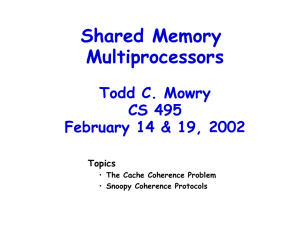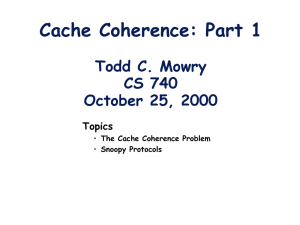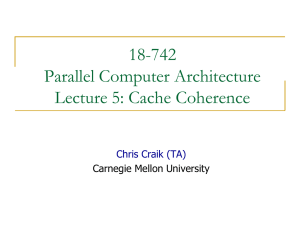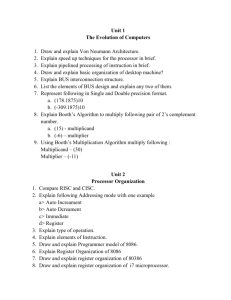Cache Coherence: Part 1 Todd C. Mowry CS 740 November 4, 1999
advertisement
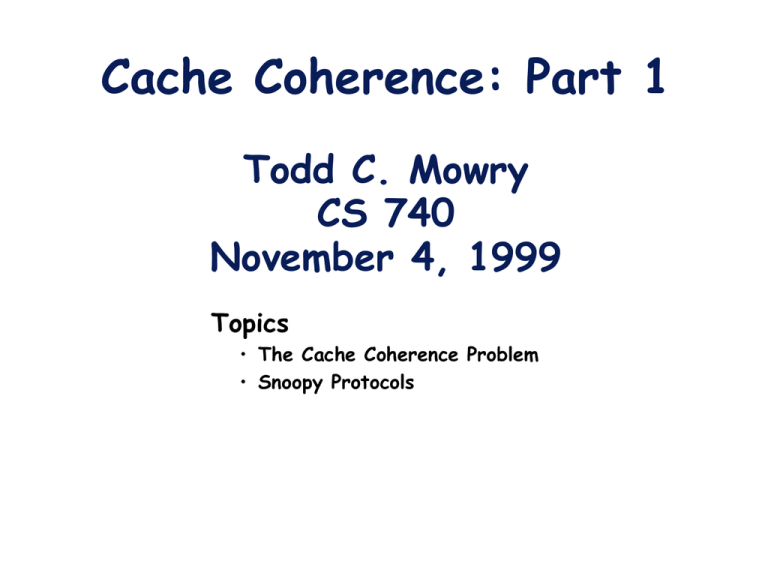
Cache Coherence: Part 1 Todd C. Mowry CS 740 November 4, 1999 Topics • The Cache Coherence Problem • Snoopy Protocols The Cache Coherence Problem P2 P1 u=? $ P3 u=? 4 $ u=7 $ 5 u:5 u:5 1 I/O devices u:5 2 Memory –2– CS 740 F’99 3 A Coherent Memory System: Intuition Reading a location should return latest value written (by any process) Easy in uniprocessors • Except for I/O: coherence between I/O devices and processors • But infrequent so software solutions work – uncacheable operations, flush pages, pass I/O data through caches Would like same to hold when processes run on different processors • E.g. as if the processes were interleaved on a uniprocessor The coherence problem is more pervasive and performance-critical in multiprocessors • has a much larger impact on hardware design –3– CS 740 F’99 Problems with the Intuition Recall: • Value returned by read should be last value written But “last” is not well-defined! Even in sequential case: • “last” is defined in terms of program order, not time – Order of operations in the machine language presented to processor – “Subsequent” defined in analogous way, and well defined In parallel case: • program order defined within a process, but need to make sense of orders across processes Must define a meaningful semantics • the answer involves both “cache coherence” and an appropriate “memory consistency model” (to be discussed in a later lecture) –4– CS 740 F’99 Formal Definition of Coherence Results of a program: values returned by its read operations A memory system is coherent if the results of any execution of a program are such that for each location, it is possible to construct a hypothetical serial order of all operations to the location that is consistent with the results of the execution and in which: 1. operations issued by any particular process occur in the order issued by that process, and 2. the value returned by a read is the value written by the last write to that location in the serial order Two necessary features: • Write propagation: value written must become visible to others • Write serialization: writes to location seen in same order by all – if I see w1 after w2, you should not see w2 before w1 – no need for analogous read serialization since reads not visible to others –5– CS 740 F’99 Cache Coherence Solutions Software Based: • often used in clusters of workstations or PCs (e.g., “Treadmarks”) • extend virtual memory system to perform more work on page faults – send messages to remote machines if necessary Hardware Based: • two most common variations: – “snoopy” schemes » rely on broadcast to observe all coherence traffic » well suited for buses and small-scale systems » example: SGI Challenge – directory schemes » uses centralized information to avoid broadcast » scales well to large numbers of processors » example: SGI Origin 2000 –6– CS 740 F’99 Shared Caches • Processors share a single cache, essentially punting the problem. • Useful for very small machines. • E.g., DPC in the Encore, Alliant FX/8. • Problems are limited cache bandwidth and cache interference • Benefits are fine-grain sharing and prefetch effects P P P P P Crossbar Shd. Cache 2-4 way interleaved cache Memory Memory –7– CS 740 F’99 Snoopy Cache Coherence Schemes Basic Idea: • all coherence-related activity is broadcast to all processors – e.g., on a global bus • each processor (or its representative) monitors (aka “snoops”) these actions and reacts to any which are relevant to the current contents of its cache – examples: » if another processor wishes to write to a line, you may need to “invalidate” (I.e. discard) the copy in your own cache » if another processor wishes to read a line for which you have a dirty copy, you may need to supply Most common approach in commercial multiprocessors. Examples: • SGI Challenge, SUN Enterprise, multiprocessor PCs, etc. –8– CS 740 F’99 Implementing a Snoopy Protocol Cache controller now receives inputs from both sides: • Requests from processor, bus requests/responses from snooper In either case, takes zero or more actions • Updates state, responds with data, generates new bus transactions Protocol is a distributed algorithm: cooperating state machines • Set of states, state transition diagram, actions Granularity of coherence is typically a cache block • Like that of allocation in cache and transfer to/from cache –9– CS 740 F’99 Coherence with Write-through Caches Pn P1 Bus snoop $ $ Mem I/O devices Cache-memory transaction • Key extensions to uniprocessor: snooping, invalidating/updating caches – no new states or bus transactions in this case – invalidation- versus update-based protocols • Write propagation: even in inval case, later reads will see new value – inval causes miss on later access, and memory up-to-date via write-through – 10 – CS 740 F’99 Write-through State Transition Diagram PrRd/— PrWr/BusWr V BusWr/— PrRd/BusRd I PrWr/BusWr Processor-initiated transactions Bus-snooper-initiated transactions • Two states per block in each cache, as in uniprocessor – state of a block can be seen as p-vector • Hardware state bits associated with only blocks that are in the cache – other blocks can be seen as being in invalid (not-present) state in that cache • Write will invalidate all other caches (no local change of state) – can have multiple simultaneous readers of block,but write invalidates them – 11 – CS 740 F’99 Write-through State Transition Diagram PrRd/— PrWr/BusWr V BusWr/— PrRd/BusRd I PrWr/BusWr Processor-initiated transactions Bus-snooper-initiated transactions • Two states per block in each cache, as in uniprocessor – state of a block can be seen as p-vector • Hardware state bits associated with only blocks that are in the cache – other blocks can be seen as being in invalid (not-present) state in that cache • Write will invalidate all other caches (no local change of state) – can have multiple simultaneous readers of block,but write invalidates them – 12 – CS 740 F’99 Problem with Write-Through High bandwidth requirements • Every write from every processor goes to shared bus and memory • Consider a 500MHz, 1CPI processor, where 15% of instructions are 8-byte stores • Each processor generates 75M stores or 600MB data per second • 1GB/s bus can support only 1 processor without saturating • Write-through especially unpopular for SMPs Write-back caches absorb most writes as cache hits • Write hits don’t go on bus • But now how do we ensure write propagation and serialization? • Need more sophisticated protocols: large design space – 13 – CS 740 F’99 Write-Back Snoopy Protocols No need to change processor, main memory, cache … • Extend cache controller and exploit bus (provides serialization) Dirty state now also indicates exclusive ownership • Exclusive: only cache with a valid copy (main memory may be too) • Owner: responsible for supplying block upon a request for it Design space • Invalidation versus Update-based protocols • Set of states – 14 – CS 740 F’99 Invalidation-based Protocols “Exclusive” state means can modify without notifying anyone else • i.e. without bus transaction • Must first get block in exclusive state before writing into it • Even if already in valid state, need transaction, so called a write miss Store to non-dirty data generates a read-exclusive bus transaction • Tells others about impending write, obtains exclusive ownership – makes the write visible, i.e. write is performed – may be actually observed (by a read miss) only later – write hit made visible (performed) when block updated in writer’s cache • Only one RdX can succeed at a time for a block: serialized by bus Read and Read-exclusive bus transactions drive coherence actions • Writeback transactions also, but not caused by memory operation and quite incidental to coherence protocol – note: replaced block that is not in modified state can be dropped – 15 – CS 740 F’99 Update-based Protocols A write operation updates values in other caches • New, update bus transaction Advantages • Other processors don’t miss on next access: reduced latency – In invalidation protocols, they would miss and cause more transactions • Single bus transaction to update several caches can save bandwidth – Also, only the word written is transferred, not whole block Disadvantages • Multiple writes by same processor cause multiple update transactions – In invalidation, first write gets exclusive ownership, others local Detailed tradeoffs more complex – 16 – CS 740 F’99 Invalidate versus Update Basic question of program behavior • Is a block written by one processor read by others before it is rewritten? Invalidation: • Yes => readers will take a miss • No => multiple writes without additional traffic – and clears out copies that won’t be used again Update: • Yes => readers will not miss if they had a copy previously – single bus transaction to update all copies • No => multiple useless updates, even to dead copies Need to look at program behavior and hardware complexity Invalidation protocols much more popular • Some systems provide both, or even hybrid – 17 – CS 740 F’99 Basic MSI Writeback Inval Protocol States • Invalid (I) • Shared (S): one or more • Dirty or Modified (M): one only Processor Events: • PrRd (read) • PrWr (write) Bus Transactions • BusRd: asks for copy with no intent to modify • BusRdX: asks for copy with intent to modify • BusWB: updates memory Actions • Update state, perform bus transaction, flush value onto bus – 18 – CS 740 F’99 State Transition Diagram PrRd/— PrWr/— M BusRd/Flush PrWr/BusRdX S BusRdX/Flush BusRdX/— PrRd/BusRd PrRd/— BusRd/— PrWr/BusRdX I • Write to shared block: – Already have latest data; can use upgrade (BusUpgr) instead of BusRdX • Replacement changes state of two blocks: outgoing and incoming – 19 – CS 740 F’99 State Transition Diagram PrRd/— PrWr/— M BusRd/Flush PrWr/BusRdX S BusRdX/Flush BusRdX/— PrRd/BusRd PrRd/— BusRd/— PrWr/BusRdX I • Write to shared block: – Already have latest data; can use upgrade (BusUpgr) instead of BusRdX • Replacement changes state of two blocks: outgoing and incoming – 20 – CS 740 F’99 Satisfying Coherence Write propagation is clear Write serialization? • All writes that appear on the bus (BusRdX) ordered by the bus – Write performed in writer’s cache before it handles other transactions, so ordered in same way even w.r.t. writer • Reads that appear on the bus ordered wrt these • Writes that don’t appear on the bus: – sequence of such writes between two bus xactions for the block must come from same processor, say P – in serialization, the sequence appears between these two bus xactions – reads by P will seem them in this order w.r.t. other bus transactions – reads by other processors separated from sequence by a bus xaction, which places them in the serialized order w.r.t the writes – so reads by all processors see writes in same order – 21 – CS 740 F’99 Lower-level Protocol Choices BusRd observed in M state: what transition to make? Depends on expectations of access patterns • S: assumption that I’ll read again soon, rather than other will write – good for mostly read data – what about “migratory” data » I read and write, then you read and write, then X reads and writes... » better to go to I state, so I don’t have to be invalidated on your write • Synapse transitioned to I state • Sequent Symmetry and MIT Alewife use adaptive protocols Choices can affect performance of memory system – 22 – CS 740 F’99 MESI (4-state) Invalidation Protocol Problem with MSI protocol • Reading and modifying data is 2 bus transactions, even if no sharing – e.g. even in sequential program – BusRd (I->S) followed by BusRdX or BusUpgr (S->M) Add exclusive state: write locally without xaction, but not modified • Main memory is up to date, so cache not necessarily owner • States – invalid – exclusive or exclusive-clean (only this cache has copy, but not modified) – shared (two or more caches may have copies) – modified (dirty) • I -> E on PrRd if no other processor has a copy – needs “shared” signal on bus: wired-or line asserted in response to BusRd – 23 – CS 740 F’99 MESI State Transition Diagram PrRd PrWr/— M BusRd/Flush BusRdX/Flush PrWr/— PrWr/BusRdX E BusRd/ Flush PrRd/— BusRdX/Flush PrWr/BusRdX S BusRdX/Flush PrRd/ BusRd (S ) PrRd/— BusRd/Flush PrRd/ BusRd(S) I • BusRd(S) means shared line asserted on BusRd transaction • Flush’: if cache-to-cache sharing (see next), only one cache flushes data • MOESI protocol: Owned state: exclusive but memory not valid – 24 – CS 740 F’99 MESI State Transition Diagram PrRd PrWr/— M BusRd/Flush BusRdX/Flush PrWr/— PrWr/BusRdX E BusRd/ Flush PrRd/— BusRdX/Flush PrWr/BusRdX S BusRdX/Flush PrRd/ BusRd (S ) PrRd/— BusRd/Flush PrRd/ BusRd(S) I • BusRd(S) means shared line asserted on BusRd transaction • Flush’: if cache-to-cache sharing (see next), only one cache flushes data • MOESI protocol: Owned state: exclusive but memory not valid – 25 – CS 740 F’99 Lower-level Protocol Choices Who supplies data on miss when not in M state: memory or cache Original, lllinois MESI: cache, since assumed faster than memory • Cache-to-cache sharing Not true in modern systems • Intervening in another cache more expensive than getting from memory Cache-to-cache sharing also adds complexity • How does memory know it should supply data (must wait for caches) • Selection algorithm if multiple caches have valid data But valuable for cache-coherent machines with distributed memory • May be cheaper to obtain from nearby cache than distant memory • Especially when constructed out of SMP nodes (Stanford DASH) – 26 – CS 740 F’99 Dragon Write-back Update Protocol 4 states • Exclusive-clean or exclusive (E): I and memory have it • Shared clean (Sc): I, others, and maybe memory, but I’m not owner • Shared modified (Sm): I and others but not memory, and I’m the owner – Sm and Sc can coexist in different caches, with only one Sm • Modified or dirty (D): I and nobody else No invalid state • If in cache, cannot be invalid • If not present in cache, can view as being in not-present or invalid state New processor events: PrRdMiss, PrWrMiss • Introduced to specify actions when block not present in cache New bus transaction: BusUpd • Broadcasts single word written on bus; updates other relevant caches – 27 – CS 740 F’99 Dragon State Transition Diagram PrRd/— BusUpd/Update PrRd/— BusRd/— E Sc PrRdMiss/BusRd(S) PrRdMiss/BusRd(S) PrWr/— PrWr/BusUpd(S) PrWr/BusUpd(S) BusUpd/Update BusRd/Flush PrWrMiss/BusRd(S) PrWrMiss/(BusRd(S); BusUpd) Sm M PrWr/BusUpd(S) PrRd/— PrWr/BusUpd(S) BusRd/Flush – 28 – PrRd/— PrWr/— CS 740 F’99 Dragon State Transition Diagram PrRd/— BusUpd/Update PrRd/— BusRd/— E Sc PrRdMiss/BusRd(S) PrRdMiss/BusRd(S) PrWr/— PrWr/BusUpd(S) PrWr/BusUpd(S) BusUpd/Update BusRd/Flush PrWrMiss/BusRd(S) PrWrMiss/(BusRd(S); BusUpd) Sm M PrWr/BusUpd(S) PrRd/— PrWr/BusUpd(S) BusRd/Flush – 29 – PrRd/— PrWr/— CS 740 F’99 Lower-level Protocol Choices Can shared-modified state be eliminated? • If update memory as well on BusUpd transactions (DEC Firefly) • Dragon protocol doesn’t (assumes DRAM memory slow to update) Should replacement of an Sc block be broadcast? • Would allow last copy to go to E state and not generate updates • Replacement bus xaction is not in critical path, later update may be Shouldn’t update local copy on write hit before controller gets bus • Can mess up serialization Coherence, consistency considerations much like write-through case In general, many subtle race conditions in protocols But first, let’s illustrate quantitative assessment at logical level – 30 – CS 740 F’99 Assessing Protocol Tradeoffs Tradeoffs affected by performance and organization characteristics Decisions affect pressure placed on these Part art and part science • Art: experience, intuition and aesthetics of designers • Science: Workload-driven evaluation for cost-performance – want a balanced system: no expensive resource heavily underutilized Methodology: • Use simulator; choose parameters per earlier methodology (default 1MB, 4-way cache, 64-byte block, 16 processors; 64K cache for some) • Focus on frequencies, not end performance for now – transcends architectural details, but not what we’re really after • Use idealized memory performance model to avoid changes of reference interleaving across processors with machine parameters – Cheap simulation: no need to model contention – 31 – CS 740 F’99 Impact of Protocol Optimizations (Computing traffic from state transitions discussed in book) Effect of E state, and of BusUpgr instead of BusRdX 200 180 Address bus Data bus 140 80 120 100 Traffic (MB/s) Traffic (MB/s) 160 80 60 40 70 Address bus 60 Data bus 50 40 30 20 OS-Data/III OS-Data/3St OS-Data/3St-RdEx E OS-Code/III OS-Code/3St OS-Code/3St-RdEx Appl-Data/III Appl-Data/3St Appl-Data/3St-RdEx Appl-Code/3St-RdEx Appl-Code/III E 0 Appl-Code/3St t Ex x Radix/3St-RdEx 10 Raytrace/3St Raytrace/3St-RdEx t Radix/III Radix/3St Raytrace/III Ill d Radiosity/3St Radiosity/3St-RdEx Radiosity/III LU/3St-RdEx LU/III LU/3St Barnes/III Barnes/3St Barnes/3St-RdEx 0 Ocean/III Ocean/3S Ocean/3St-RdEx x l 20 • MSI versus MESI doesn’t seem to matter for bw for these workloads • Upgrades instead of read-exclusive helps • Same story when working sets don’t fit for Ocean, Radix, Raytrace – 32 – CS 740 F’99 Impact of Cache Block Size Multiprocessors add new kind of miss to cold, capacity, conflict • Coherence misses: true sharing and false sharing – latter due to granularity of coherence being larger than a word • Both miss rate and traffic matter Reducing misses architecturally in invalidation protocol • Capacity: enlarge cache; increase block size (if spatial locality) • Conflict: increase associativity • Cold and Coherence: only block size Increasing block size has advantages and disadvantages • Can reduce misses if spatial locality is good • Can hurt too – increase misses due to false sharing if spatial locality not good – increase misses due to conflicts in fixed-size cache – increase traffic due to fetching unnecessary data and due to false sharing – can increase miss penalty and perhaps hit cost – 33 – CS 740 F’99 Impact of Block Size on Miss Rate Results shown only for default problem size: varied behavior • Need to examine impact of problem size and p as well (see text) 0.6 12 Upgrade Upgrade False sharing 0.5 False sharing 10 True sharing True sharing Capacity Capacity Cold Cold Miss rate (%) 8 0.3 6 4 0.1 2 •Working 8 Raytrace/8 Raytrace/16 Raytrace/128 Raytrace/256 6 Radix/256 Raytrace/32 Raytrace/64 8 4 2 Radix/32 Radix/64 Radix/128 Radix/16 8 Radix/8 Ocean/256 Ocean/128 Ocean/64 Ocean/32 Ocean/8 Ocean/16 Radiosity/128 Radiosity/256 0 Radiosity/64 Radiosity/16 Radiosity/32 Radiosity/8 Lu/256 Lu/64 Lu/128 Lu/16 Lu/32 Lu/8 Barnes/256 Barnes/64 Barnes/128 Barnes/16 Barnes/32 0 6 8 0.2 Barnes/8 Miss rate (%) 0.4 set doesn’t fit: impact on capacity misses much more critical – 34 – CS 740 F’99 Impact of Block Size on Traffic Traffic affects performance indirectly through contention 10 1.8 Address bus Address bus 9 • Results different than for miss rate: traffic almost always increases • When working sets fits, overall traffic still small, except for Radix • Fixed overhead is significant component – So total traffic often minimized at 16-32 byte block, not smaller • Working set doesn’t fit: even 128-byte good for Ocean due to capacity – 35 – CS 740 F’99 Ocean/256 Ocean/64 0 Ocean/128 0 Ocean/32 0.2 Ocean/8 1 Ocean/16 0.4 LU/256 2 LU/64 0.6 LU/128 3 0.8 LU/32 Raytrace/128 Raytrace/256 Raytrace/64 Raytrace/16 Raytrace/32 Raytrace/8 Radiosity/8 Radiosity/16 Radiosity/32 Barnes/256 Barnes/64 Barnes/128 Barnes/16 Barnes/32 0 Radiosity/64 4 Radiosity/128 28 Radiosity/256 2 0.02 4 1 LU/8 0.04 5 1.2 LU/16 0.06 Traffic (bytes/FLOP) 0.08 6 Radix/256 0.1 7 Radix/64 0.12 Data bus 1.4 Radix/8 Traffic (bytes/instruction) 8 Radix/128 0.14 Address bus 1.6 Data bus Radix/32 Data bus Radix/16 0.16 Barnes/8 Traffic (bytes/instructions) 0.18 Making Large Blocks More Effective Software • Improve spatial locality by better data structuring • Compiler techniques Hardware • Retain granularity of transfer but reduce granularity of coherence – use subblocks: same tag but different state bits – one subblock may be valid but another invalid or dirty • Reduce both granularities, but prefetch more blocks on a miss • Proposals for adjustable cache size • More subtle: delay propagation of invalidations and perform all at once – But can change consistency model: discuss later in course • Use update instead of invalidate protocols to reduce false sharing effect – 36 – CS 740 F’99 Update versus Invalidate Much debate over the years: tradeoff depends on sharing patterns Intuition: • If those that used continue to use, and writes between use are few, update should do better – e.g. producer-consumer pattern • If those that use unlikely to use again, or many writes between reads, updates not good – “pack rat” phenomenon particularly bad under process migration – useless updates where only last one will be used Can construct scenarios where one or other is much better Can combine them in hybrid schemes (see text) • E.g. competitive: observe patterns at runtime and change protocol Let’s look at real workloads – 37 – CS 740 F’99 Update vs Invalidate: Miss Rates 2.50 0.60 False sharing True sharing 0.50 Capacity 2.00 Cold Miss rate (%) Miss rate (%) 0.40 0.30 1.50 1.00 0.20 0.50 0.10 Radix/upd Radix/mix Radix/inv Raytrace/upd Raytrace/inv Ocean/upd Ocean/mix Ocean/inv LU/upd 0.00 LU/inv 0.00 • Lots of coherence misses: updates help • Lots of capacity misses: updates hurt (keep data in cache uselessly) • Updates seem to help, but this ignores upgrade and update traffic – 38 – CS 740 F’99 Upgrade and Update Rates (Traffic) Upgrade/update rate (%) LU/inv LU/upd Ocean/inv Ocean/mix Ocean/upd Raytrace/inv Raytrace/upd Upgrade/update rate (%) Radix/upd CS 740 F’99 8.00 Radix/mix 7.00 6.00 5.00 4.00 3.00 2.00 1.00 0.00 Radix/inv – 39 – 2.50 2.00 1.50 1.00 0.50 0.00 • Update traffic is substantial • Main cause is multiple writes by a processor before a read by other – many bus transactions versus one in invalidation case – could delay updates or use merging • Overall, trend is away from update based protocols as default – bandwidth, complexity, large blocks trend, pack rat for process migration • Will see later that updates have greater problems for scalable systems
